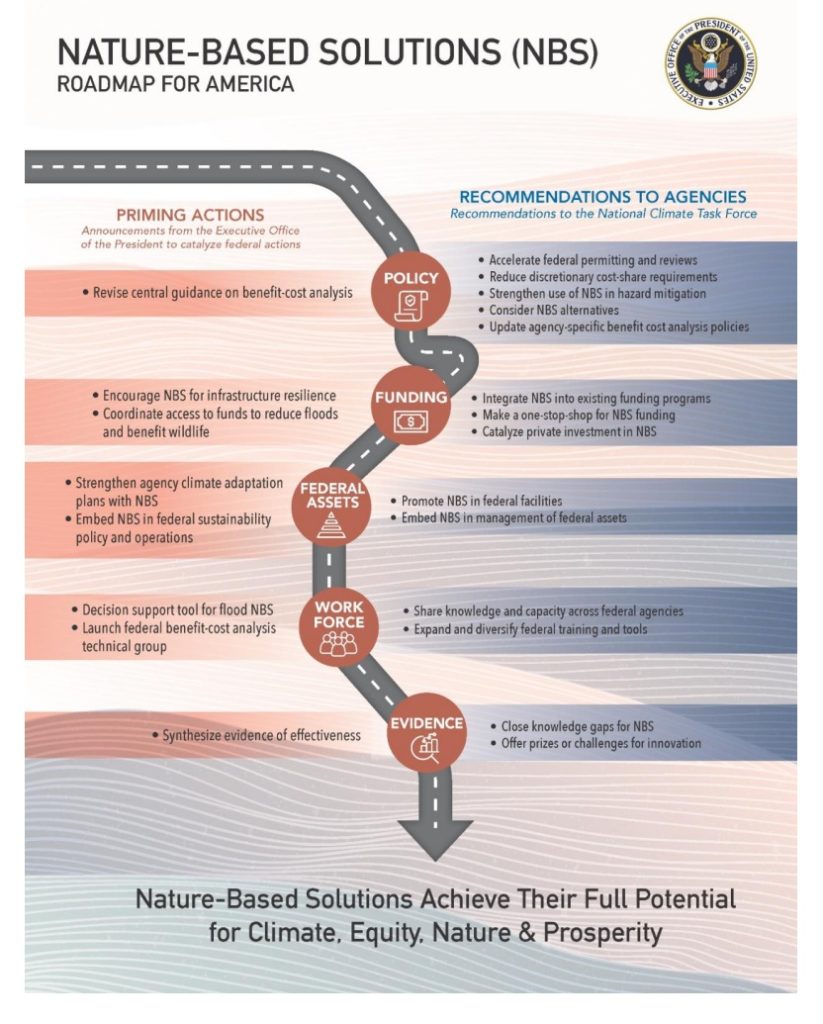A pair of reports recently released by the White House detail a comprehensive strategy to scale up the use of nature-based solutions — protecting or restoring natural landscapes and building green infrastructure — to better address such issues as climate change, habitat loss, and environmental inequity.
The reports, announced in November during the United Nations Framework Convention on Climate Change’s 27th Conference of the Parties (COP27) in Sharm El-Sheikh, Egypt, respond to a call from President Biden earlier this year to identify opportunities to expand the use of nature-based solutions across the federal government and beyond. They include the Nature-Based Solutions Roadmap, which presents a five-point plan to better facilitate the use of nature-based solutions via federal spending protocols, as well as the Nature-Based Solutions Resource Guide, which provides examples of ways federal agencies have used nature-based solutions to achieve various goals. Both reports were authored by the White House Council on Environmental Quality, the White House Office of Science and Technology Policy, and the White House Office of Domestic Climate Policy, in collaboration with federal agencies.
“There is often an assumption that tackling the climate crisis requires only technological solutions or that ‘innovation’ means ‘technology,’” authors of the Nature-Based Solutions Roadmap write. “This report presents compelling evidence that nature-based solutions are innovative, and that they are highly complementary to necessary technological solutions. Nature-based solutions and technology can be powerful allies. Indeed, the climate crisis demands that we deploy all available, proven, science- and evidence-based solutions.”
Roadmap Toward Resilience
According to the Nature-Based Solutions Roadmap, researchers estimate that properly designed and maintained nature-based solutions have the potential to provide more than one-third of the climate change mitigation needed to stabilize warming in the U.S. to below 2° C (3.6° F) by 2100 and would do so at a lower cost than conventional approaches. Unlocking the full potential of nature-based solutions, according to the report, will require a combination of policy, funding, and research, as well as growing the nature-based workforce and highlighting successful demonstration projects.

Despite their varied functions and focuses, authors broadly advise federal agencies to update internal policies as well as external guidance to create additional flexibility for nature-based solutions. This is particularly important in the case of permitting processes, agency review methods, and project cost-share requirements, all of which may exclude nature-based solutions as acceptable options to achieve a specified goal. The White House Office of Management and Budget, for example, is currently reviewing its guidance on benefit-cost analyses to help federal agencies more accurately quantify the value of nature-based solutions in regulatory decisions, the guide describes.
By extending eligibility for nature-based solutions into new and existing grant and incentive programs, report authors describe that federal agencies can enable states, municipalities, and nonprofit groups to view nature-based solutions as a more desirable option. Some federal agencies are also pioneering public innovation challenges as well as innovative financing models to spur adoption of nature-based solutions within the private sector, authors write.
Many agencies maintain large amounts of federally owned land, which creates an opportunity to demonstrate the possibilities of what nature-based solutions can achieve for other landowners. According to the roadmap, construction standards for federal facilities should specifically require the use of nature-based solutions wherever possible. Agencies should also lead efforts to perform research on best practices for measuring and verifying the long-term performance of nature-based solutions on federal property in order to build private-sector confidence that these projects are effective. The U.S. Department of Defense, which owns approximately 11 million ha (27 million ac) of land, is currently developing policies to prioritize nature-based solutions on U.S. military installations as well as implement long-term performance monitoring strategies, for example.
Demonstrating Natural Potential
The Nature-Based Solutions Resource Guide contains several examples of how federal projects have mobilized nature to improve stormwater management and discourage flooding. In addition to profiles of 30 government-led, nature-based solutions by various offices and agencies, the guide also compiles more than 175 links to resources, tools, guidance, and technical assistance from federal sources on ways to make the most of natural landscapes and green infrastructure.
In New Orleans, for example, the U.S. Federal Emergency Management Agency (FEMA) provided a grant that funded the construction of an innovative “stormwater park” in a neighborhood located entirely below sea level. Known as the Mirabeau Water Garden, the park features expansive bioretention measures that capture, measure, and store stormwater while also addressing chronic land subsidence issues. The project, estimated to reduce damages from a 10-year storm event by as much as 40%, reduces flood damages by a value equal to at least twice the amount of capital invested by FEMA while also improving the quality of life of neighborhood residents, according to the guide.
For a decade, the U.S. Environmental Protection Agency has managed a unique innovation challenge targeting college students. The annual Campus RainWorks Challenge tasks teams of students to design green infrastructure interventions that aim to solve stormwater management challenges on their specific college campuses in the form of either small-scale demonstration projects or far-reaching master plans. According to the guide, more than 800 teams originating from more than 270 U.S. colleges and universities have taken on the Campus RainWorks Challenge to date, resulting in a growing collection of nature-based stormwater projects while providing valuable real-world experience to the burgeoning green infrastructure workforce.
Top image courtesy of U.S. National Archives

ABOUT THE AUTHOR
Justin Jacques is editor of Stormwater Report and a staff member of the Water Environment Federation (WEF). In addition to writing for WEF’s online publications, he also contributes to Water Environment & Technology magazine. Contact him at jjacques@wef.org.




